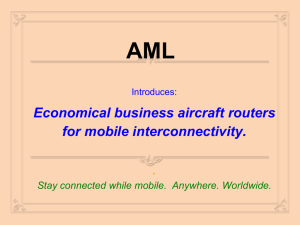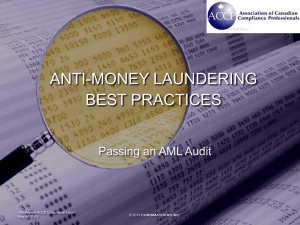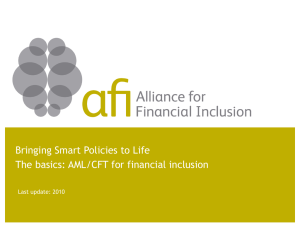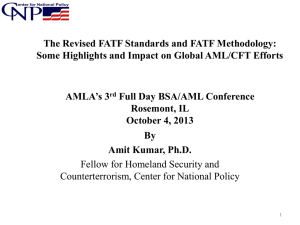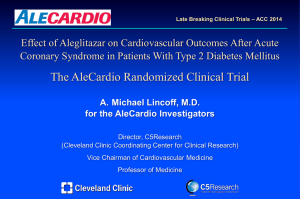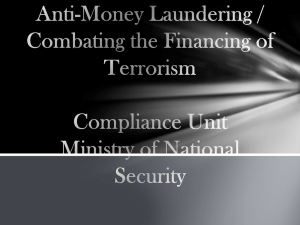The Intricacies of Compliance
advertisement
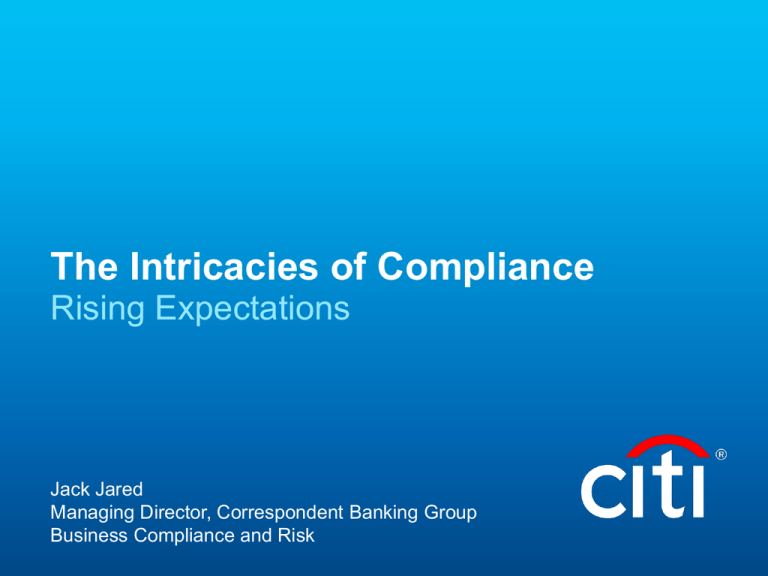
The Intricacies of Compliance Rising Expectations Jack Jared Managing Director, Correspondent Banking Group Business Compliance and Risk Agenda • • • • 2 Money Laundering – the scope Cost of Non-Compliance Global AML Governance Program A Look at Citi’s Strategy Money Laundering – What is it? 3 • The attempt to make ill-gotten gains appear legitimate by the movement of funds to conceal the true source, ownership or use and of the funds. The source of the funds may include criminal activities such as drug trafficking, arms sales, embezzlement, extortion, ransom. • The use of legitimate money for illegitimate purposes (e.g. terrorist financing). The motivation behind terrorist financing is generally ideological, as opposed to profit-seeking. • Although the estimates of criminal proceeds and related financial crime are substantial, money launderers conceal the true nature of their activities and illicit finance is comingled with the trillions of dollars processed by financial institutions each day. $1.6 trillion Conservative estimate of global money laundering according to UN office of Drugs and Crime. (2009) $1 trillion World Bank estimate of annual worldwide bribery. $320 billion UN estimate of global illegal narcotics trade. $39 billion International Labor Organization estimate of Human Trafficking value. $30 million CIA’s estimate of Al-Qaeda's annual budget. 1.5 million Number of Suspicious Activity Reports filed in the U.S. in 2012. (FinCEN) Stopping illicit money flows is a national security imperative. Global banks have global responsibilities to prevent participation in illicit or suspect transactions. Carl Levin, December 2012 4 Getting Global Regulatory Attention US Department of the Treasury Office of the Comptroller of the Currency Financial Crimes Enforcement Network Office of Foreign Asset Control • • • • Non Governmental Bodies • • • • • 5 United Nations Financial Action Task Force (FATF) Transparency International Global Witness World Bank European Union • European Commission • Bank for International Settlements Regional Governmental Regulators • Monetary Authority of Singapore • The People’s Bank of China • Attorney’s General Department (Australia) • Council of Financial Activities Control (Brazil) • Financial Monitoring Committee (Russia) Hot AML Regulatory Topics 6 • Compliance Risk Management/Controls • Correspondent Banking – Nested Relationships – Funds flow between high risk geographies (originator/beneficiary) – Client documentation – Affiliates and Branch networks • Remittance payments/MSB’s • Stored Value Cards (Pre-paid) • Increased coordination across regulatory agencies—inside US and US across other jurisdictions • Senior Public Figures/ Politically Exposed Persons (PEPS) • Virtual Currency If you think Compliance is expensive, try non-compliance 7 The fine from regulators is the easy part… Attention from other Regulators Increased headcount Increased technology budget Reputational damage Consultancy fees Loss of partners, clients Long periods of Regulatory oversight 8 AML Program Governance AML Governance should be Global, Cross sector and Cross Functional Board Level Oversees management's implementation of a strong global AML Program Global Governance and Risk Provides strategic direction and drives execution of the AML Program in the businesses AML Steering Committees Ensures management prioritizes the requirements of the AML Program and provides resources and information as may be necessary to complete implementation of regulatory commitments and other enhancements Business Level Ensures AML program requirements are properly executed and AML risks are monitored and controlled 9 Citi’s Global AML Program Objectives Protect Citi by preventing, detecting and reporting money laundering, terrorist financing and other illicit activities Manage AML risk in an integrated manner across products, business lines and geographies supported by globally consistent systems and processes Meet regulatory obligations and expectations Mitigate legal, financial, compliance and reputational risk Citi’s Bank Secrecy Act / Anti-Money Laundering Program AML Lifecycle Prevention Know Your Customer Detection Monitoring & Investigations Reporting Feedback Loop, Account Restrictions and Closures Governance & Enterprise-wide Controls Legal Requirements AML Program is “risk based” and must include: • A system of internal controls • Independent testing of AML Compliance • Designation of an AML Compliance Officer • Training for appropriate personnel 10 Policies: Define standards for conduct Processes: Oversight and measurement Personnel: Sufficient levels, appropriate skills and training Controls: Effectiveness, testing and manage project execution AML Lifecycle Prevention Know Your Customer Detection Monitoring & Investigations Reporting Feedback loop Customer Risk Scoring Escalations Transaction Monitoring/ Alerts Customer On-boarding Customer Maintenance Name Screening (Sanctions, Red Flag, Senior Public Figure) Suspicious Activity Reporting (SARs) Case Review Investigations Global Investigations (Inputs from internal and external sources) Currency Transaction Reporting (CTRs) Account Restrictions and Closures Governance and Enterprise-wide Controls Policies Policies & Standards Procedures 11 Processes Governance & Management Issues Management Risk Assessment Metrics / Analytics Personnel Controls Staff / Talent Training & Communications Roles and Responsibilities Program Management Compliance Testing Independent Testing Governance and Enterprise-wide Controls Policies Processes • Roles and Responsibilities • • • • • Defines standards; provides advice on regulatory requirements and expectations; provides guidance on client and product risk Primary ownership for development and production of the Risk Assessments, Metrics and Analytics Manages projects, related issues and escalations and reporting Oversees the IMR process Provides financial and third party management • Personnel Timely and accurate completion of KYC due diligence and periodic review requirements; Responds to transaction monitoring and investigation case inquiries • AML Compliance Business AML Plan Implementation AML Operations • • Compliance and Architecture Strategy • Internal Audit AML Technology • Compliance Testing • Meets the regulatory requirement to conduct independent testing of the AML program Note: Additional roles within the organization provide advice, expertise and are complementary to the roles shown above. 12 Controls Manages transaction monitoring Hubs Provides support for MANTAS and case management systems testing and implementation Defines and maintains the technology strategy for AML Implements and maintains environment controls, including data quality and completeness Conducts testing of AML program and processes Thank you 13

